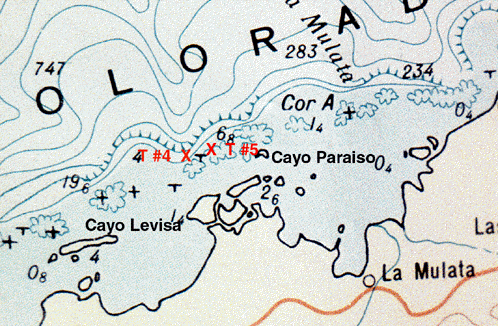

INDEX: Cayo Paraiso
Cuba Report - Cayo Paraiso

If the biota, in the course of aeons, has built something we like but do not understand, then who but a fool would discard seemingly useless parts? To keep every cog and wheel is the first precaution of intelligent tinkering. Aldo Leopold, Round River, 1993.
Reef Relief Founders.com

Transect 4 and 5 (above)
Within fifteen miles of Bahia Honda the Archipielago de los Colorados and the coral reef begins. The barrier coral reef extends westward offshore of fringing mangroves cays that stretch deep into the Yucatan Peninsula in a setting very similar to the Florida Keys. One of the first cays in the archipielago that is accessible to cruising yachts with a safe entry through the reef is Cayo Paraiso. In June of 1998 Cayo Paraiso was off limits to visiting boats. Our dive was restricted to an area on the western perimeter of this cay. This island is rich in history from the fabled days when Ernest Hemingway spent time there. The condition of the Acropora palmata in this area was of great interest to many coral reef scientists because of a history of abundance there.
Transect #4 was the only transect site that we dove on during this expedition. The second transect #5 at Cayo Paraiso was snorkeled.
June 7, l998 Cayo Paraiso Transect #4 water green
Transect 7 was in twenty feet of water at N22 55 00 W 83 28.5, a position west of Cayo Paraiso. This dive took place in the early morning on a once majestic coral reef. This reef is dominated by a wide variety of macroalgae and exhibited symptoms of Black Band disease and other non- specific 'white' coral diseases.
This was the first reef to have well established coral colonies of considerable size. An interesting observation was the fact that near many coral outcroppings the Thalassia sea grass had grown right up to the edge of the coral without the presence of sandy 'halos' that normally surround them. The lack of a sandy halo surrounding the perimeter of the majority of coral formations indicates an absence of fish. Very few fish were observed. Many of the sea fans exhibited symptoms of aspergillosis.
June 7, l998 Cayo Paraiso Transect #5 water green
This was a very shallow snorkel transect at N 22 55. 579 W 083 27. 106 Once again macroalgae dominated the sea floor. This was a flat shelf exposed to northerly winds with quite a bit of Acropora palmata in various stages of health. The extremely shallow palmata was completely dead. The other palmata colonies appeared to be in decline. Very few Coralliophila (coral eating snails) were observed. There was a great deal of the White Plague Type II observed and much of the Acropora palmata was covered in macroalgae.



